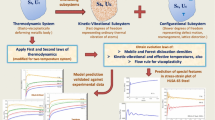Abstract
Fragmentation of the structure of lattice disorientations at high plastic strains of metal crystals is studied. The medium is modelled by the geometrically nonlinear elastoplastic Cosserat continuum. The points of the continuum are identified with dislocation cells with a frozen crystal lattice.
Similar content being viewed by others
REFERENCES
V. V. Rybin, High Plastic Strains and Failure of Metals [in Russian], Metallurgiya, Moscow (1986).
B. Bay, N. Hansen, D. A. Hughes, and D. Kuhlmann-Wilsdorf, “Evolution of FCC deformation structures in polyslip," Acta Metall. Mater., 40, No. 2, 205-219 (1992).
A. F. Revuzhenko, Mechanics of Elastoplastic Media and Nonstandard Analysis [in Russian], Izd. Novosib. Gos. Univ., Novosibirsk (2000).
E. C. Aifantis, “Pattern formation in plasticity," Int. J. Eng. Sci., 33, No. 15, 2161-2178 (1995).
É. L. Aero, “Microscale strains in a two-dimensional lattice — structural transitions and bifurcation at critical shear," Fiz. Tverd. Tela, 42, No. 6, 1113-1119 (2000).
R. Hill and J. W. Hutchinson, “Bifurcation phenomena in the plane tension test," J. Mech. Phys. Solids, 23, 239-264 (1975).
R. J. Asaro, “Geometrical effects in the inhomogeneous deformation of ductile single crystals," Acta Metall., 27, 445-453 (1979).
R. Hill, “A general theory of uniqueness and stability in elastic-plastic solids," J. Mech. Phys. Solids, 6, No. 3, 236-249 (1958).
R. Hill, “Some basic principles in the mechanics of solids without a natural time," J. Mech. Phys. Solids, 7, No. 3, 209-225 (1959).
H. Ziegler, Principles of Structural Stability, Blaisdell, Toronto (1968).
W. Nowacki, Theory of Elasticity [Russian translation], Mir, Moscow (1975).
V. D. Klyushnikov, Lecture Notes on the Stability of Deformable Systems [in Russian], Izd. Mosk. Univ., Moscow (1986).
R. Hill, “Acceleration waves in solids," J. Mech. Phys. Solids, 10, No. 1, 1-16 (1962).
R. Hill, “On constitutive inequalities for simple materials. Part 1,” J. Mech. Phys. Solids, 16, No. 4, 229-242 (1968).
Author information
Authors and Affiliations
Rights and permissions
About this article
Cite this article
Keller, I.É., Trusov, P.V. Fragmentation of metals at high strains: a mechanism of formation of spatially‐modulated vortex structures. Journal of Applied Mechanics and Technical Physics 43, 320–327 (2002). https://doi.org/10.1023/A:1014774230687
Issue Date:
DOI: https://doi.org/10.1023/A:1014774230687



